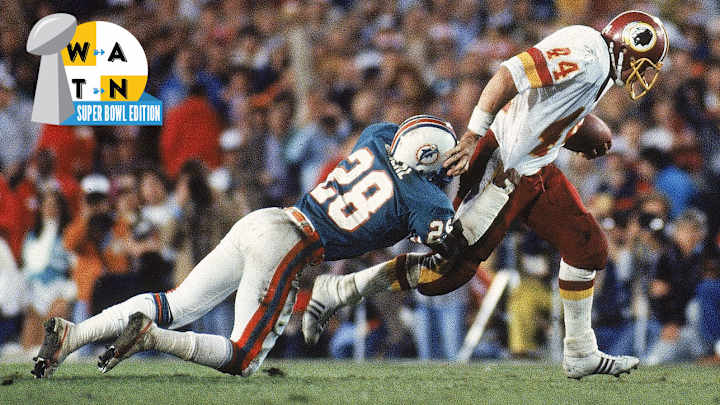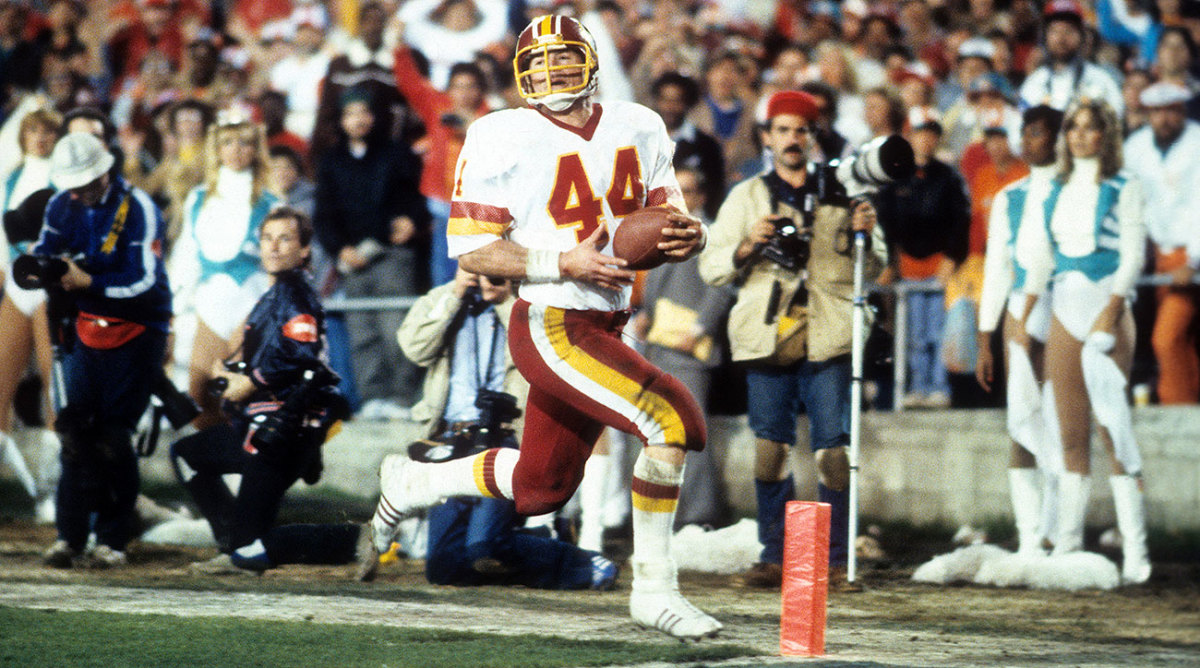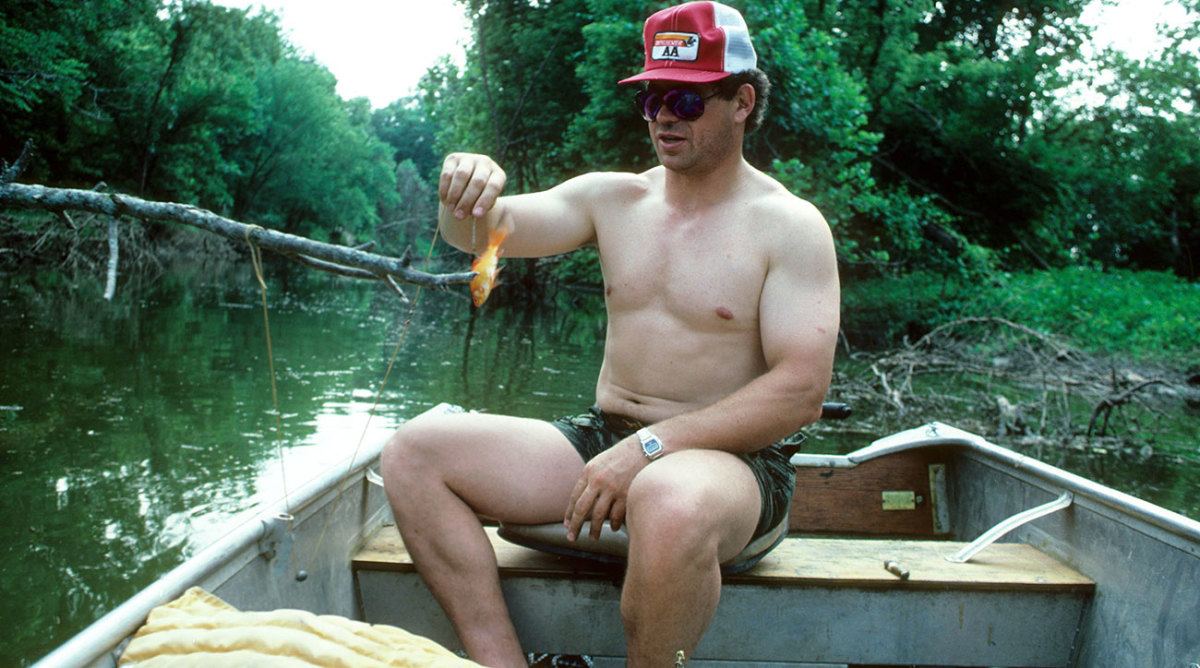John Riggins is happy to be far removed from his Super Bowl stardom

John Riggins is doing yoga; Ashtanga yoga to be exact. Which means that, right now, he’s working his way through the sun salutation: bending over to touch his toes, kicking his legs back into a pushup position, and then folding himself back up, standing, and repeating. If you had to pick out the Hall of Fame athlete in the room, the 67-year-old in all black probably would not be your first choice, especially as the dozen practitioners go through the postures for a fourth time.
Returning from downward dog, Riggins’s right foot skids on its way to his shoulders before he can stand up. Then, lifting that knee towards his chest, he shows a slight wobble. Sweat begins to accumulate. The studio owner, Keith Moore, all limbs and soothing guidance, keeps an eye on Riggins while pacing the room. In this sleepy neighborhood on the west edge of Washington, D.C., in a second-floor studio full of deep breaths and the scent of organic soap, Keith encourages the class. “Feel free to fall over,” he says, his voice just above a whisper. “Go ahead and knock your neighbor over.” And as Riggins pulls his right leg across his body, it seems he just might.
But no.
• Where Are They Now:Antwaan Randle El | David Tyree | John Kasay
This is still John Riggins we are talking about. Things may be different now for the protagonist of Washington’s greatest sports moment. But this much remains true of the Super Bowl XVII MVP who, at 33 years old, made history on a fourth-and-one touchdown scamper: Riggins does not go down easy.
Well, except for that fateful night, exactly two years after the Super Bowl, when he did drop in front of D.C.’s biggest power players, Supreme Court Justice Sandra Day O’Connor included. On Jan. 30, 1983, in Pasadena, Calif., Riggins declared himself king. On Jan. 30, 1985, as national papers would have you believe, he was the fool. All along, Riggins wanted to be something else entirely.

The truth was, Riggins never loved football. He respected gridiron greats, but revered mountain men like Daniel Boone and Davy Crockett. Growing up, Riggins’s favorite activity was running down to the creek to catch bullheads and snakes. He dreamed of visiting the sequoias of California or the canyons of Arizona. But that wasn’t really an option for a boy in 1950s Centralia, Kans. (pop. 512). Nor was it what John’s strict father, Frank, wanted. Instead he played football, and because he was good at it, he kept playing.
“The one thing about sports that did appeal to me was, you don’t really have to be an adult,” he says. “You can be Peter Pan for a good long while."
But at the University of Kansas, Riggins felt like a second fiddle to his older brother, Frank Jr. After being drafted by the Jets, he seemed to be stuck in the same role, the opening act for Joe Namath. He escaped there in 1976, only to land in Washington, where George Allen used him as a blocking back.
In 1980, nine years into his NFL career, he nearly veered in a different direction. He refused to sign a contract and spent the season back in Kansas. He knew football was wrecking his body. He completed a college economics class. He was ready to settle down.
However, less than a year into his new life, Riggins “had a definite cash-flow problem,” he says, and new Redskins coach Gibbs convinced him to return. “I’m broke and I’m back,” Riggins told the press in 1981. He was mainly a short-yardage back that year, but he led the league in rushes during the strike-shortened ’82 season as Washington finished 8–1.
Despite his lack of passion for the sport, one image always pushed Riggins: the championship parade. “It goes back to being a kid in Kansas reading about the Yankees,” he says. “Thinking about all these people coming out, riding in limousines, everybody cheering.” A middle child, he yearned to be celebrated. “To me, that was just magical.”
Antwaan Randle El has no regrets and plenty on his plate in life after Super Bowl glory
On the day after the 1982 regular season ended, with the Redskins atop the NFC East, Riggins drove into the team’s facility determined to achieve the dream. There, he came across assistant head coach Joe Bugel. “Joe, get me the ball,” Riggins said. “I’m your guy.”
“I’d never been that guy, before or since,” Riggins says. “I never volunteered for extra work. But in this moment I didn’t want to look back on it and think I didn’t let them know I was ready.” Over Washington’s first three playoff games, Riggins would carry the ball 98 times for 444 yards, but his true opus wouldn’t come until Super Bowl XVII.
During the lead-up to the game, Pasadena was treated to classic Riggins. Attempting to find joy in a sport he felt little passion for, the football star had developed a fun-loving persona. Or maybe it was in his DNA. When he was four, he splashed water all over Centralia’s baseball team from behind the dugout. In high school, he secretly got his hair shaved the night before a regional basketball tournament, cut jokes in the middle of football huddles and caused disturbances during Sunday school. Now, at the pinnacle of his sport, Riggins felt freer than ever. He showed up to a Super Bowl party with a tuxedo, a top hat and a cane. For the media session, he wore camouflage pants.
Come game day, he managed to—in the contemporaneous words of Paul Zimmerman—“grab modern NFL football by the scruff of the neck and toss it a few decades back into a simpler era,” setting Super Bowl records for carries (38) and yards (166).
• From the Vault: SI’s Super Bowl XVII game story, “Hail to the Redskins!”
His grandest moment came with just under 10 minutes left in the game. On fourth-and-one, with Washington trailing 17–13, Gibbs turned to Bugel. “What do you think here?” The answer was obvious: 70 Chip. Give it to John. Riggins took the hand-off, ran to his left, shed Dolphins corner Don McNeal and high-tailed it 43 yards into the end zone. Fourth-and-one, 43 yards, for No. 44. Washington would go on to win its first Super Bowl, 27–17. “I was out there to get a first down,” Riggins says, “And all of a sudden, I get by the one guy and there was nobody left.”
John’s brother Bill, watching from the stands, was reminded of the Centralia days, when his brother would wear down opposing defenses and then spring big gainers late. A friend sitting next to him said, “That’s the game and that’s the MVP.” Mr. and Mrs. Riggins had tears in their eyes. “It was as if everything John ever did in his whole career was geared to this,” his late mother, Mildred told Zimmerman at the time. Maybe so, but he wasn’t prepared for what came next.

After all that, Riggins missed the parade. As Most Valuable Player, he was forced to stay in Pasadena an extra day for a celebratory luncheon before flying back (making matters worse, he was awarded a Pontiac Trans-Am that he couldn’t squeeze into). When he woke up the next morning, he saw Maureen Bunyan reporting live from the parade route, and then he spotted the team in the background. “I thought, What the hell?” he says. “So I called Redskins Park—no answer, no answer. Then I look at my watch and figure out it’s actually noon.” He had forgotten to change the time back. He missed his chance to see 500,000 Redskins fans line the streets of the nation’s capital in the hopes of celebrating their hero. “Go figure.”
• From the Vault (1983): Back home in Kansas with Super Bowl hero John Riggins
The following season was Riggins’s best, as he ran for a career-high 1,347 yards (300 more than any 34-year-old ever has) and a league-leading 24 touchdowns. But it ended in heartbreak, as Marcus Allen broke his Super Bowl yardage record in the Raiders’ 38–9 romp over Washington. Riggins averaged just 2.5 yards per carry in the loss. Back trouble limited him in 1984, and then everything came tumbling down the following year.
For a decade, Riggins had waited for his big NFL break. And he got it in 1983. But that meant a guy who tolerated sports because it meant he could stay a kid had to rein in his boisterous persona now that he was on a national stage. At the same time, he faced the prospect of growing old, of bad knees and a bad back, of knowing his time in the league could end any day. Many athletes dream of going out on top, but for Riggins, it wasn’t that easy.
So of course he was on edge heading into the Washington Press Club’s annual Salute to Congress Dinner. He had a couple beers that afternoon with a friend and then a double scotch at the Washington Sheraton. Seated with Virginia governor Chuck Robb and Supreme Court Justice Sandra Day O’Connor, Riggins managed to knock over multiple bottles of red wine. And then, fatefully, as O’Connor prepared to leave, Riggins protested. “Come on, Sandy baby,” he said to the first female justice on the Supreme Court. “Loosen up. You’re too tight.” Soon after, Riggins was asleep under the table.
The next day, the news was everywhere. This had been a Press Club event, after all. Friends called Riggins from South America and Japan to ask what had happened. Three weeks later, he escaped it all by going on a safari in Zimbabwe. There, local guides helped with his luggage. “I saw them laughing and I didn’t think anything of it. I thought maybe we brought the wrong gear or something,” Riggins says. “Then one of them said, ‘Aren’t you the guy that fell asleep on the floor?’”
Three months later, the Redskins traded a first-round pick for running back George Rogers, a potential replacement for Riggins, who was once again in the midst of salary negotiations. That summer an anonymous club official told The New York Times, “A lot of people here don’t want him back.” He eventually did sign a one-year deal but was forced to answer questions about his drinking habits when he got to camp. He ran for 100 yards just three times that season and averaged under 30 per game over the final four weeks.
John Kasay's fateful Super Bowl kickoff stays with him, but doesn't haunt him
When Gibbs told him there wasn’t a spot for him on the 1986 roster, Riggins challenged any potential replacement to beat him in a 60-yard race. “Should my challenge go unanswered,” Riggins said, “I want everyone to know I wish the Redskins well.” A year later, he criticized Rogers on the radio, saying “he’s not the answer as the natural guy to follow me after I left the game.”
During a divorce a few years later, Riggins spent 18 months living out of an Airstream trailer. In 1990, upon his induction into the Ring of Honor at RFK Stadium, he opted to wear his full uniform rather than a coat and tie, bursting onto the field after the other honorees had been recognized, all so that he could hear the roar of the crowd one more time. He tried his hand at acting and had a couple run-ins with the law, though a drunk-in-public charge was dropped and a lawsuit stemming from an incident outside a late-night bistro was settled. “I think a lot of times, he just wants to be an ordinary Joe,” Bill told The Washington Post at the time. “They put him up on a pedestal so high. I think he’s passed that and wants to go on to new things. I don’t know if he really knows what that will be.”
At his Hall of Fame ceremony in 1992, Riggins struck a bittersweet tone. “I’d hate like hell to think this is as good as it gets,” he said. “But maybe it is for me.”

Riggins, still trying his hand at acting 10 years after his Hall of Fame induction, landed a part in an off-Broadway run of Gillette. His character, a hardscrabble Texan named Mickey, starts the play in search of enough money to buy a fishing boat and disappear.
“There was a time when that appealed to me,” Riggins, 52, said during the play’s run. “But by the end of the play Mickey makes the decision that you’ve got to fit in. You can’t hunt and fish forever. You’ve got to accept your lot in life. I think that’s kind of where I am.”
In 1996, Riggins had started that process by marrying Lisa-Marie Felter in New York (Mayor Rudy Giuliani presided). Then they had their first child, Hannah, and Riggins grew adept at navigating NYC’s subways with her in a stroller, heading north to Lincoln Circle so they could take the loop around Central Park. He cooked for the family in their midtown Manhattan apartment and watched Hannah as Lisa-Marie studied to become a lawyer. “That’s when things really changed for me,” Riggins says. “When I found somebody I could trust, I had a different take on life. That’s when adulthood finally started.”
Riggins accepted that his big acting break might never come and committed himself to sports broadcasting. To advance his career, the family moved back to the D.C. area in 2008. Riggins currently does pre-game and midweek analysis for ESPN 980. When he’s not on the air, Riggins has turned himself into a house husband; Lisa-Marie says she hasn’t cooked for her kids in six years. Last February, Riggins told The New York Post his favorite meal “would be some kind of red meat.” But then he read The China Study and decided to go vegan. He stopped drinking for six months, too, before his family convinced him to rejoin the party. Now his favorite meal is made with whole barley, steel cut oats, hemp hearts, almonds, blueberries and molasses. Currently, he’s lighter than he’s been since his Centralia days, eating like the animals he hunted. “I think at the end of his career, he had a tough time,” Bill says, “but he is really a happy person today.”
After The Helmet Catch, David Tyree took a winding road to his second Giants job
Riggins still looks forward to solo trips to his plot of land in Kansas, where he gets to play wild man, waking up at 4 a.m. after braving 20-degree nights. Human adulation can be addicting, he says, and that time alone is something of a detox after playing the role of showman for so long. But he’s largely accepted that his chance to be a wide-eyed explorer have passed. Instead, he saw more than he ever imagined. And he’s come to terms with the public persona he developed along the way.
Though he keeps most of his medals, plaques and jerseys buried in a closet, Riggins’s heroics are far from forgotten in Washington. When he shows up at FedEx Field, several fans in No. 44 jerseys find him. A barricade in the parking lot still features the play design of 70 Chip, and the press box still is decorated with gigantic posters from that moment and others during his career.
When Riggins comes across fans, though, he hopes that they don’t know too much about his past. “I prefer that we are on even footing,” he says, “compared to anything they’ve read about me or some kind of preconceived conception of who I am they might have.” When he was introduced to a college player last month, he was happy to recount the details of 70 Chip, as the kid—a running back himself—peppered Washington’s all-time leading rusher with detailed questions. But more often, it’s off-the-field stuff that fans want to know about. Many of the compliments Riggins gets don’t quite land like praise. Still, he indulges them.
Though those fans might be surprised to hear about the yoga, the diet, the tranquility, “I’ve always been that guy,” Riggins says. “I think more than likely, there’s been an image created for me that’s part of who I am, but there’s more to it than that.” Riggins always did things his own way. Combine that with his desire to entertain the press and be one of the boys, even when he was 10 years their senior, and it’s easy to see how things got out of hand at times. Plus, Riggins never really adjusted to being a celebrity after reaching that status so late in his career. “I run into trouble because I’m not self-conscious,” he said in 1985. “It’s hard to think of myself as Big John Riggins. I still think of myself as Bobby John Riggins from Centralia, Kansas. I go ahead and do something I want to do, then all of a sudden, I realize somebody’s watching me.” Now he fancies himself a fading star, able to go about his own business.
Sports Illustrated's 52 Super Bowl Stories
In 2015, a friend of his started a small brewery, and the two got to discussing the idea of a John Riggins beer. Given his Czech ancestry, Riggins decided it would be cool to make a pilsner. But not just any pilsner. He tried every one he could get his hands on, and then showed up at the brewery with a cooler packed with 30 different options. From there, he and the staff took shots of each beer, Riggins saying what he liked and what he didn’t. The result has been a “big hit,” says brewery owner Art Major, to the point where he can hardly keep up with demand.
They named the beer “4th & 1” in honor of Riggins’s enduring legacy. On the can, No. 44 shoves McNeal in a callback to that magical moment. Just below the logo, though, are two other words, from a different time in his life, but part of the same legacy. Maybe a mark of bygone shame, but also something of a credo: LOOSEN UP.
